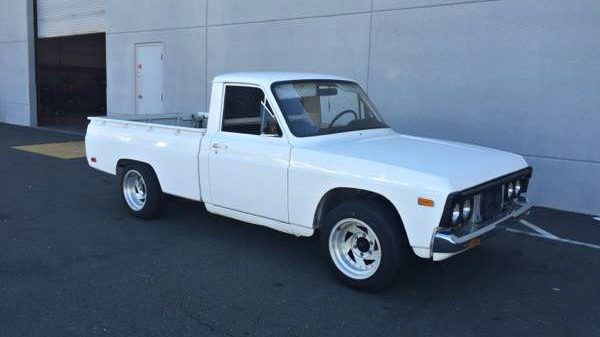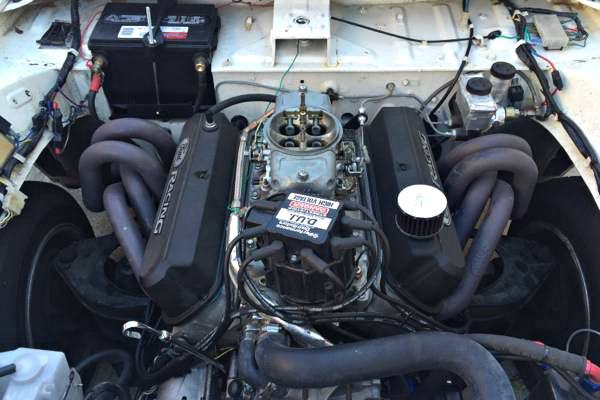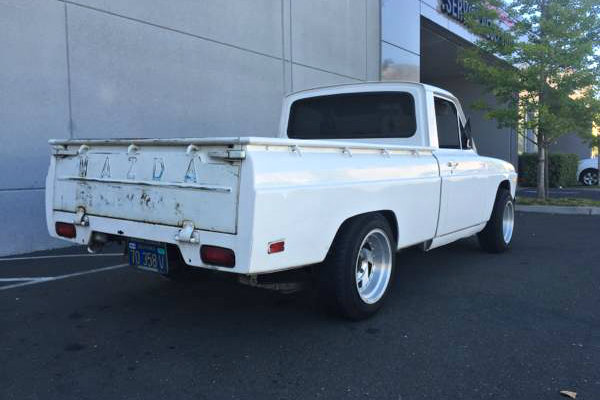Many of us have seen and still see early American market Toyota and Datsun/Nissan pickup trucks. But I ask you, when was the last time you saw an early American market Mazda pickup? They certainly aren’t as common as their Japanese counterparts, but this Mazda has a secret. An American V8 secret. In very reasonable condition, this small truck is ready to put a grin on your face at the price tag of $8,500. Find it here on craigslist out of Vallejo, California.
So what may be this Mazda’s secret? Well the secret is a Ford 306 cubic inch V8 backed by a T-5 manual transmission and a 9” rear with a spool. That’s a big secret for a little truck. The 306 is heavily outfitted with performance parts that will guarantee that this Mazda is a complete hand full to drive. The inner fenders have been removed and the headers are fed through the wheel wells. The T-5 has a hydraulic clutch set up, and the braking no longer has a power assist, although it appears to be an upgraded manual master cylinder. This massive engine does fit under the stock hood, although it would appear that there is no air cleaner. I imagine a skinny air cleaner can likely be found to work with this set up.
Looking inside of this small truck brings nostalgia as to what these early Japanese trucks were like. No carpet with a rubber like full cabin matt, with very simple door panels and dash layout. Surprisingly this interior isn’t too shabby from the test of time. The door panels look excellent, and the dash looks nice, although outfitted with a carpeted cover. When was the last time you saw Mazda’s early trademark of the lower case “m”? Well thankfully this Mazda has its original steering wheel, and its original horn button adorned with the “m”. I would imagine the bench seat is beat, as it is covered in a sleek J.C. Whitney seat cover. What is cool, is that looking inside of this truck you don’t really see anything out of place, or that signifies the massive engine under the hood. The shifter is located further back than the stock unit, and a nice, low key, plate has been fitted to finish off the relocation.
The only exterior features that give any hints to the massive engine are the aftermarket wheels, and the aluminum radiator. Looking past those items, the exterior appears stock and solid. The tailgate shows some paint wear, but otherwise this truck is clean wearing white paint. There is no evident rust, but there are some areas that may have been subject to rust at some point. There is no rear bumper, and there also appears to be no grill either. Small, fast, and fun, this Mazda is a unique classic that there can’t be that many left of. Would you pick up this Japanese Restomod?








They should have stuck a rotary in it, like its cousin.
Maybe it already had a stuck rotary, so they pulled it and replaced with a tranny shredding 306 small block ford? dont get me wrong I love the old rotary P/Us. still I would consider this one..
This model was never available with a rotary. The Rotary pickup was available only from 1974 to 1977 and
like this
Might be sold or something else is up as it’s been flagged for removal.
Found it listed again:
http://sfbay.craigslist.org/eby/cto/5975267168.html
I agree–I would have gone rotary. I had an RX4 in high school, and my dad had a terrible Ford Courier at one point, so we could have made our own!
Not an oriental vehicle guy but years ago I raced a rotary version of this little truck down the hill from Big Bear to San Beradino with my Porsche Karman Coupe. The Mazda was really fast but was hopeless in the corners. With a little straight away, it would catch right up. I don’t think it ever got past me but it was a fun drive. The gas engines in this truck had great design but were poorly built. The rotaries did not have long life expectancies either and I am sure there few survivors, this might be the highest and best use.the rotaries also got terrible fuel economy, worse than a full size truck.
I couldn’t help but cringe at your near miss, which I respectfully point out only to be helpful.
While using Oriental in this context (describing an inanimate item) is strictly correct, it is a dated term best used to describe antiquities, and certainly never a person’s ethnic origins.
“Asian” would be a suitable replacement that would raise fewer eyebrows and prevent any unfortunate slipups.
Again, not trying to embarass you, we’re all easy going here, but that might not fly so well at a dinner party :)
I have never been concerned with offending people with properly used language. There is little chance of being embarrassed by a Canadian socialist in any event.
I owned a ’74 rotary truck and unfortunately had to relocate to California with it in the early 90s. At the time it was subject to a smog test and no matter how I tried I couldn’t get it to pass so I wound up dumping it.
It would be exempt now. Bummer, that was a fun truck. As Dave mentioned, the fuel economy – especially when driven spiritedly was atrocious.
I assume that this conversion has engineering approval. Having said that, I do find it a bit disconcerting how close the exhaust headers run to the brake master cylinder. Maybe it’s just an optical illusion (at least I hope it is!).
Ditch the trailer triangles and swap on some period slotted mags or something and it’d really help the exterior of the truck. Be a fun little cruise around rig. I dig the small trucks, though lean more towards the Toyota end of things. They’re fun, regardless of make, and typically super easy to work on since compared to new cars they’re about as mechanically simple as a lawn tractor.
R O T A R Y – or NOT AT ALL-!
A rotary is best in these trucks small powerfull and fast very fast
Dave if u put some $$$ in a rotary engine the right apex and side
seals u cant go wrong it just wont brake down even turbo charged
rotary last a long time of hi revving and drag racing
some more
They are German, off course they are interesting and fun, just not durable in an industrial type application like a pickup. In a sports car………great fun and who would care about the fuel economy. I have always been fascinated by them and I am sure there are many improvements since there first incarnation. In a super 7, they are incredible. They operate similar to my old turbine powered ship, like it they burn 3 times the fuel of a conventional internal combustion engine. NSU RO 80’s were common the years I lived in Germany, the standing joke was when two of them met on the street, the drivers would acknowledge each other by holding up fingers that represented how many engines they had gone through.